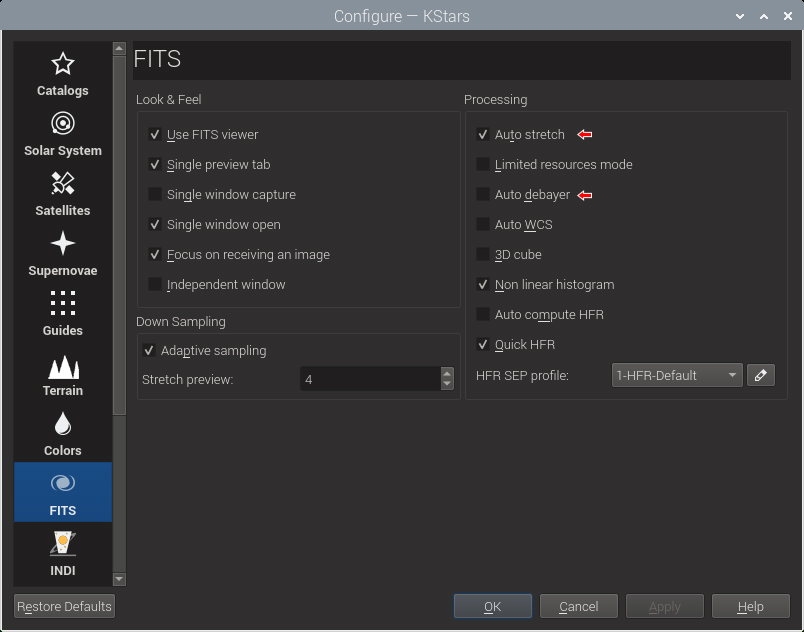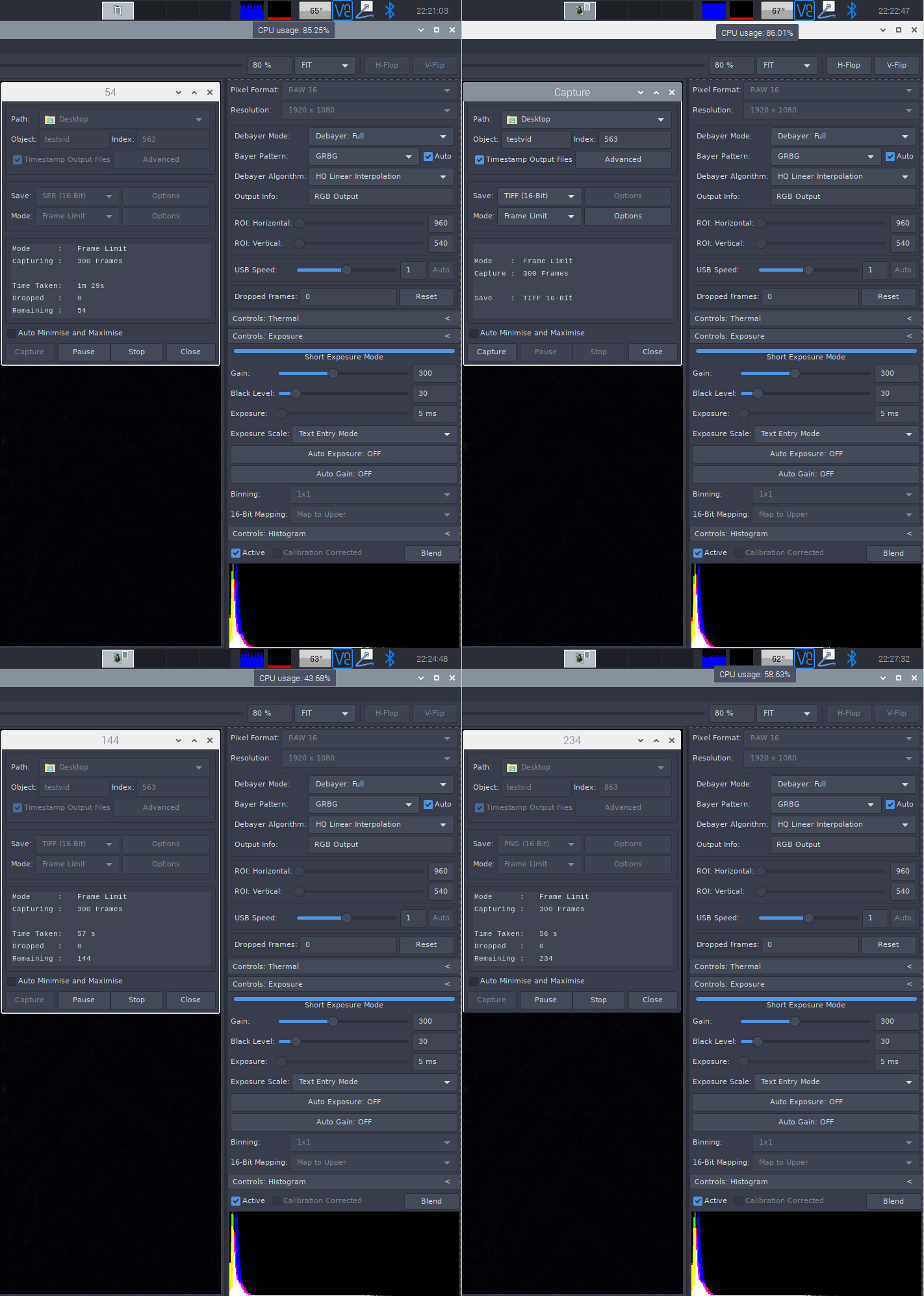×
INDI Library v2.0.7 is Released (01 Apr 2024)
Bi-monthly release with minor bug fixes and improvements
Plate Solving With An SV305 Planetary Camera As Primary Camera
Hi folks, I would like to use my SVBONY SV305 Pro camera as a primary camera. In order to use it as such, and especially to be able to plate solve with it, do I need to set AUTO DEBAYERING to ON in the FITS configuration settings? What about AUTO STRETCH? Are there any other particular settings (anywhere) that should be on, off, or set to a given parameter?
Thanks for any info on this.
Thanks for any info on this.
Attachments:
Please Log in or Create an account to join the conversation.
- Nigel Dunmore
-

- Offline
- Premium Member
-

- Posts: 155
- Thank you received: 12
Replied by Nigel Dunmore on topic Plate Solving With An SV305 Planetary Camera As Primary Camera
afaik those settings are only related to the fits viewer, they don’t actually change the operation of the camera or the images it collects.
Regards
Nigel
Regards
Nigel
1 year 7 months ago
#86321
Please Log in or Create an account to join the conversation.
Replied by Phil on topic Plate Solving With An SV305 Planetary Camera As Primary Camera
So does Ekos know how to properly use the FITS image data to plate solve?
1 year 7 months ago
#86322
Please Log in or Create an account to join the conversation.
- Nigel Dunmore
-

- Offline
- Premium Member
-

- Posts: 155
- Thank you received: 12
Replied by Nigel Dunmore on topic Plate Solving With An SV305 Planetary Camera As Primary Camera
The indi driver generates the fits image that ekos then uses. It’s just a file format that enables more information to be stored alongside the actual image information. Seems to be used by a lot of astronomy related applications such as pixinsight, DSS, startools etc
I use an sv305 camera with my guidescope to do polar alignment which involves platesolving. Only downside I can see is it’s not a particularly high resolution (in how many pixels rather than pixel size terms) camera but depends what you are using it to take pictures of.
Regards
Nigel
I use an sv305 camera with my guidescope to do polar alignment which involves platesolving. Only downside I can see is it’s not a particularly high resolution (in how many pixels rather than pixel size terms) camera but depends what you are using it to take pictures of.
Regards
Nigel
1 year 7 months ago
#86323
Please Log in or Create an account to join the conversation.
Replied by Phil on topic Plate Solving With An SV305 Planetary Camera As Primary Camera
Thing is, I can't tell if Ekos will be able to solve, because I can't really see what it's recording. If I set the FITS viewer to debayer I can see something, but honestly I don't know if it's sufficient for Ekos to plate solve. I have the 305 on the C5 with a 2X Barlow, so I have a very narrow FOV. I have the entire astrometry database, but I think it will have to blind solve, assuming it can see something. I actually plan to shoot with AstroDMX, but first I have to get the camera locked on the target, hence why I want to plate solve (and guide) with Ekos. I would have no idea otherwise how I would find a needle like Jupiter in a haystack like a 2500mm scope with a 1/2.8" sensor attached to it.
1 year 6 months ago
#86455
Please Log in or Create an account to join the conversation.
- Nigel Dunmore
-

- Offline
- Premium Member
-

- Posts: 155
- Thank you received: 12
Replied by Nigel Dunmore on topic Plate Solving With An SV305 Planetary Camera As Primary Camera
Ah ok I see what you are getting at 
The fits viewer settings afaik don’t impact platesolving. However an image taken with the camera using the imaging module of ekos (not the platesolving module) will appear in the viewer and to make it so you can see things you will want auto stretch turned on. If you don’t have it on you can either click the stretch button in the viewer or manually move the sliders at the bottom to brighten things up.
Unfortunately I’ve no experience at the type of focal length/fov you are on about so can only offer hints/ideas/questions. So I may be talking complete rubbish in the next bits…
If using astrodmx to image that will most likely clash with the sv305 indi driver used by ekos so you will probably want to ensure you disconnect it in the indi control panel once pointing in the right direction.
How are you going to be guiding? I’ve tended to use my guide camera/scope to do my polar alignment and also do platesolving to get pointing at my target before switching to my main camera to fine tune things (I’ve got a cheap and cheerful setup so the scopes don’t quite point in the same direction). Could you get close using your guide scope then fine tune with the c5? Not sure if this stops it doing a blind solve but you could at least get it pointing somewhere known.
Have you managed to focus things? I find this the hardest part of my process and I’m at a much shorter focal length. One thing I did find was focusing using astrodmx to display and zoom in was easier than using the ekos focus module.
Finally have you tried without the barlow? This is going to make the image fainter and have a narrower fov which will make life difficult.
I’m thinking of getting a c5 or maybe c6 but probably use a reducer for galaxies etc as the planets tend to be hidden by my house so would be interested in knowing what results you get.
Regards
Nigel
The fits viewer settings afaik don’t impact platesolving. However an image taken with the camera using the imaging module of ekos (not the platesolving module) will appear in the viewer and to make it so you can see things you will want auto stretch turned on. If you don’t have it on you can either click the stretch button in the viewer or manually move the sliders at the bottom to brighten things up.
Unfortunately I’ve no experience at the type of focal length/fov you are on about so can only offer hints/ideas/questions. So I may be talking complete rubbish in the next bits…
If using astrodmx to image that will most likely clash with the sv305 indi driver used by ekos so you will probably want to ensure you disconnect it in the indi control panel once pointing in the right direction.
How are you going to be guiding? I’ve tended to use my guide camera/scope to do my polar alignment and also do platesolving to get pointing at my target before switching to my main camera to fine tune things (I’ve got a cheap and cheerful setup so the scopes don’t quite point in the same direction). Could you get close using your guide scope then fine tune with the c5? Not sure if this stops it doing a blind solve but you could at least get it pointing somewhere known.
Have you managed to focus things? I find this the hardest part of my process and I’m at a much shorter focal length. One thing I did find was focusing using astrodmx to display and zoom in was easier than using the ekos focus module.
Finally have you tried without the barlow? This is going to make the image fainter and have a narrower fov which will make life difficult.
I’m thinking of getting a c5 or maybe c6 but probably use a reducer for galaxies etc as the planets tend to be hidden by my house so would be interested in knowing what results you get.
Regards
Nigel
1 year 6 months ago
#86466
Please Log in or Create an account to join the conversation.
Replied by Phil on topic Plate Solving With An SV305 Planetary Camera As Primary Camera
Well my modus operandi is to have two profiles, one with the SV305 as the imaging camera and CEM26 mount (for plate solving to position), and a separate profile with an ASI120MM camera set as the guide camera with the CEM26, sans main camera. I can also apply a sim camera emulating the '305 FOV, but that's not really important. Once plate solved with the '305 as the main camera, I would switch profiles, start autoguiding with the ASI, and connect the '305 to AstroDMX.
However running some tests I'm seeing massive CPU usage and rising temps when running simulated shooting sessions with AstroDMX, as you can see below. When idle at shooting speed, CPU usage is around 85%(!) the temps are up around 65°C(!). The Pi is actively cooled. For some reason CPU usage drops somewhat when actually shooting. There's slightly less CPU overhead at 8 bits, but "the song remains the same". Some formats are more taxing than other.
So I'm wondering if I should just scrap planetary shooting with the Pi altogether and just use my Windows ASCOM setup tethered instead
However running some tests I'm seeing massive CPU usage and rising temps when running simulated shooting sessions with AstroDMX, as you can see below. When idle at shooting speed, CPU usage is around 85%(!) the temps are up around 65°C(!). The Pi is actively cooled. For some reason CPU usage drops somewhat when actually shooting. There's slightly less CPU overhead at 8 bits, but "the song remains the same". Some formats are more taxing than other.
So I'm wondering if I should just scrap planetary shooting with the Pi altogether and just use my Windows ASCOM setup tethered instead
Attachments:
Please Log in or Create an account to join the conversation.
Time to create page: 0.433 seconds
© 2003-2022 by INDI Library. All rights reserved.


